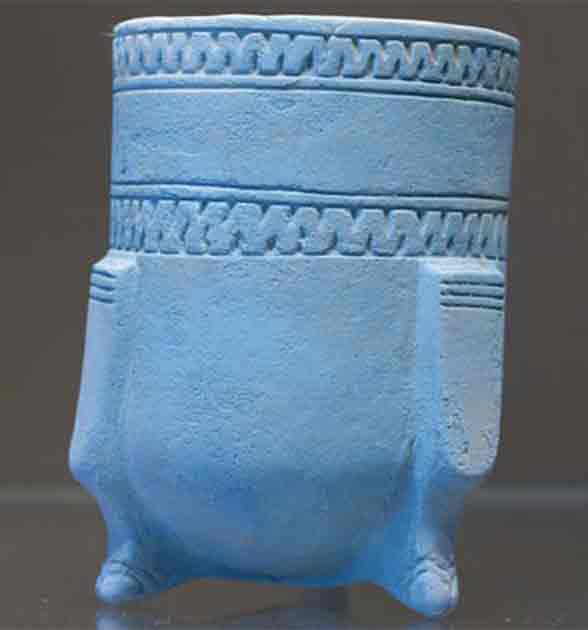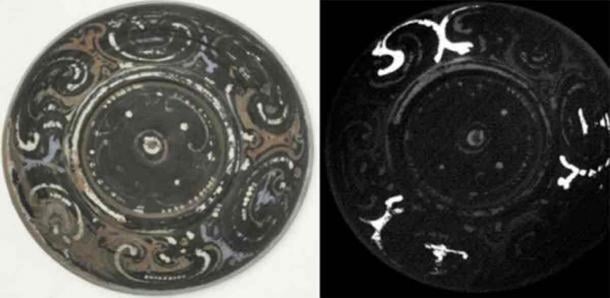Han Purple: The 2,800-Year-Old Mystery Solved by Quantum Physicists
Han purple, an artificial pigment created by the Chinese over 2,500 years ago, was used in ancient artworks such as wall paintings, the famed terracotta warriors, ceramics, metalware and jewelry. A technological wonder, the pigment was made through a complex process of grinding up raw materials in precise proportions and heating to high temperatures. So intricate was the process that it remained a mystery until 1992, when chemists were finally able to identify its composition.
But this was just the beginning. Research since then has discovered amazing properties of Han purple, including the ability to emit powerful rays of light in the near-infrared range, as well as the capability to collapse three dimensions down to two under the right conditions.

Some of the details on the famed Terracotta Warriors are believed to have been painted using Han purple pigment. (chungking / Adobe Stock)
The Rise and Fall of Han Purple
The production of Han purple, otherwise known as Chinese purple, dates back as far as 800 BC. However, it appears that it was not used in art until the Qin and Han Dynasties (221 BC to 220 AD), when it was applied to the world-famous terracotta warriors, as well as ceramics and other items.
- Only the Roman Elite Could Wear Tyrian Purple to Keep the Peasants in Their Place
- The Link Between Japanese Samurai and Real Indigo (Video)
“Prior to the nineteenth century, when modern production methods made synthetic pigments common, there were only hugely expensive purple dyes, a couple of uncommon purplish minerals, and mixtures of red and blue, but no true purple pigment – except during a few hundred years in ancient China,” wrote Samir S. Patel in Archaeology.
For an unknown reason, Han purple disappeared entirely from use after 220 AD, following the end of the Qin and Han Dynasties. It remained absent until its rediscovery by modern chemists in the 1990s, sparking renewed interest in its historical and scientific significance.

"Egyptian blue" tripodic beaker imitating lapis lazuli from South Mesopotamia. The composition of Han purple differs from Egyptian blue only in the use of barium instead of calcium. (Public domain)
Exploring Ancient Color Chemistry: Han Purple and its Synthetic Origins
Natural dyes, such as Tyrian purple (from c. 1500 BC), are organic compounds and typically made from plants or animals, like the murex snail. Han purple, however, was a synthetic pigment made from inorganic materials. This distinction marked a significant departure in the methods of pigment production during ancient times.
Only two other man-made blue or purple pigments are known to have existed in the ancient world. These include Maya blue (from c. 800 AD), made from a heated mixture of indigo and white clay, and Egyptian blue, which was used throughout the Mediterranean and the Near and Middle East from 3,600 BC to the end of the Roman Empire.
Scientist Elisabeth FitzHugh, a conservator at the Smithsonian, was the first to identify the complex synthetic compound that makes up Han purple. It is barium copper silicate, a compound that differs from Egyptian blue only through its use of barium instead of calcium.
The similarities between the colors Han purple and Egyptian blue led some early researchers to conclude that the Chinese may have learned to make the pigment from the Egyptians. However, this theory has been largely discounted as Egyptian blue was not found further East than Persia.
“There is no clear reason why the Chinese, if they had learned the Egyptian formula, would have replaced calcium with barium, which necessitates increasing the firing temperature by 100 degrees or more,” wrote Patel.
So how exactly did the Chinese stumble upon the intricate formula to make Han purple, which involved combining silica (sand) with copper and barium in precise proportions and heating to about 850-1000 °C? A team of Stanford physicists published a paper in the Journal of Archaeological Science, proposed an answer.
According to these Stanford physicists, Han purple was a by-product of the glassmaking process, as both glass and the purple pigment contain silica and barium. “Barium makes glass shinier and cloudy, which means this pigment could be the work of early alchemists trying to synthesize white jade,” claimed Gizmodo when discussing this work.
Fluorescent Properties of Han Purple / Han Purple and the collapsing of dimensions
Since its composition was first discovered, scientists have continued to investigate this unique pigment. Researchers at the British Museum discovered that, when exposed to a simple LED flashlight, Han purple emits powerful rays of light in the near-infrared range.
According to their study, published in the journal Analytical and Bioanalytical Chemistry, the Han purple pigments show up with startling clarity under the right conditions. This meant that even faint traces of the color, which are invisible to the naked eye, can be seen with infrared sensors.

A Western Han ceramic bowl from Hebei or Hanan province which contains traces of Han purple. The purple pigment becomes strongly fluorescent under infrared sensors (right). (Avery Brundage Collection)
The fluorescent properties of Han purple were not the only surprise. Quantum physicists from Stanford, Los Alamos National Laboratory and the Institute for Solid State Physics (University of Tokyo) reported that when Han purple is exposed to extreme cold and a high magnetic field, the chemical structure of the pigment enters a new state called the quantum critical point, in which three-dimension material “loses" a dimension.
“We have shown, for the first time, that the collective behavior in a bulk three-dimensional material can actually occur in just two dimensions,” Ian Fisher, an assistant professor of applied physics at Stanford said in the Stanford report. “Low dimensionality is a key ingredient in many exotic theories that purport to account for various poorly understood phenomena, including high-temperature superconductivity, but until now there were no clear examples of 'dimensional reduction' in real materials.”
- Tyrian Purple: The Secret Process Behind the World’s Most Expensive Dye (Video)
- Mummy Brown – 16th Century Paint Made from Ground Up Mummies
The scientists have proposed that this effect is due to the fact that the components of barium copper silicate are arranged like layers of tiles, so they don't stack up neatly. Each layers' tiles are slightly out of sync with the layer below them. This may frustrate the wave and force it to go two dimensional. The discovery may help understand the required properties of new materials, including more exotic superconductors.
“Han Purple was first synthesized over 2,500 years ago, but we have only recently discovered how exotic its magnetic behavior is,” explained Fisher. “It makes you wonder what other materials are out there that we haven't yet even begun to explore.”
Top image: Detail of a mural from an Eastern Han tomb (25 to 220 AD) at Zhucun, Luoyang, Henan province. The painting utilizes Han purple and Han blue pigment. Source: Public domain
References
Inglis-Arkell, E. 21 November 2014. “This 2,000-Year-Old Pigment Can Eliminate the Third Dimension” in Gizmodo. Available at: https://gizmodo.com/this-2000-year-old-pigment-can-eliminate-the-third-dime-1661476168
Liu, Z. et. al. November 2007. “Influence of Taoism on the invention of the purple pigment used on the Qin terracotta warriors” in Journal of Archaeological Science, Vol. 34, Issue 11, pp. 1878-1883. Available at: https://doi.org/10.1016/j.jas.2007.01.005
No name. 30 March 2007. “Ancient Warriors and the Origin of Chinese Purple” in Stanford Synchrotron Radiation Lightsource Science Highlights Archive. Available at: https://www-ssrl.slac.stanford.edu/content/science/highlight/2007-03-30/ancient-warriors-and-origin-chinese-purple
Patel, S. S. September / October 2007. “Purple Reign: How ancient Chinese chemists added color to the emperor’s army” in Archaeology, Vol. 60. No. 5.
West FitzHugh, E. & Zycherman, L. A. August 1992. “A Purple Barium Copper Silicate Pigment from Early China” in Studies in Conservation, Vol. 37. No. 3, pp. 145-154. Available at: https://doi.org/10.2307/1506342


















Comments
What it is saying is the effect isgenerated from only the surface….so it becomes “two dimensions”
Graphene, which forms atomic sheets, is a two dimensional system. The nanomaterial here is three dimensional but under the correct conditions the effect being studied is apparently limited to just the material’s surface. There is however some question over the definition being used here is truly limited to just the surface or perhaps is also employing the layer of atoms underneath the surface.
Dr. Derek Cunningham
Author of:
The Map that Talked - How astronomy was used to map the ancient world
The Babel Texts - Decoding the early text of the Stone Age
Scotland and Shakespeare's Third Prophecy - Recovering Scotland's Forgotten past
I had a similar reaction to the whole "dimensional" aspect of this. It sounds very interesting but the descriptions were sort of vague. So, I followed the links to relevant articles and papers and read those too. I think I have a bit more understanding of what they're on about, now.
The stuff about "collapsing a dimension" is basically saying that we expect 3D objects to always have 3D effects or interactions--so for example, when a magnetic field is being emitted from an object that has length, width, and depth; we expect the field to have length, width, and depth as well--but this is not the case with this material when it is cooled to near-absolute zero. The magnetic field it emits is collapsed in one of its dimensions.
They are theorizing that this happens because of layering. The paint crystallizes into a bunch of very thin sheets or layers, and all the atoms in a given layer are in alignment with each other, but not necessarily in alignment with the atoms in the layers above and below. Since magnetic fields are a product of atomic alignment, the magnetic field emitted by a given layer does not combine with the fields emitted by the layers above and below it. So the field has length and width, but no depth.
Since every layer is emitting a magnetic field like this, the overall effect is described not as a two dimensional magnetic field--there is depth, because the fields are stacked just like the layers of paint are--but a field that has been collapsed in one of its dimensions.
Not sure if that makes it more clear what they are talking about, lol. Describing three dimensional and two dimensional things in a one-dimensional medium(text is linear, only one dimension) is not easy.
I enjoyed this article, but you guys lost me on 3D to 2D and quantum physics is way over my head. Can someone please explain collapsing dimension in little people talk. I read it because I was interested in ancient coloring technique and was absolutely memorized with the brilliance of the color. Science lesson anyone?
of the elements of the periodic table. Flourescencent molecule absorbs UV light and emit as lower visible light. S Kean The Disappearing Spoon which I am reading again and undoubtably will reread.
Easily understandable and a fun read. I have wondered if our past cyclic conditions on Earth would act to amass or accumulate or even transmute elements via a particularly stong emission from the sun . If these cycles actually left easily accessible surface deposits of pure elements it would not be long before one of our curious selves began investigating. Our discovery of the periodic table of elements required a lot of hit and miss and tedious purifying to obtain an elemental sample.
They probably know something about quantum physics that we now are only beginning to understand.
Peace and Love,
Ricky.
Pages